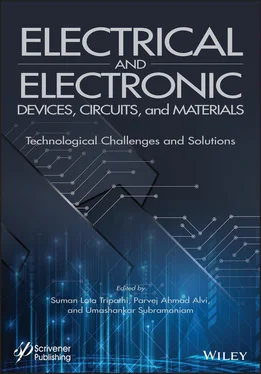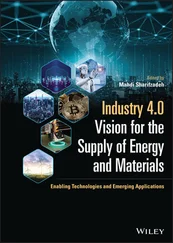To increase the energy density of the SC, various efforts have been done to tune the voltage window of the electrolytes by the addition of IL and plasticizers [51]. In continuation of this, Kang et al . [52] reported the preparation of solid electrolyte comprising poly(ethylene glycol) behenyl ether methacrylate-gpoly((2-acetoacetoxy)ethyl methacrylate) (PEGBEM-g-PAEMA) graft copolymer by one-pot free-radical polymerization process for application in bendable SC. The ionic conductivity of the PE was 1.23 × 10 -3S/cm and the increase was attributed to high polarity and amorphous nature. Two SC cells were fabricated using PEGBEM-g-PAEMA (Cell-1) and PVA/H 3PO 4(Cell-2) as a solid electrolyte and activated carbon as an electrode. The PEGBEM-g-PAEMA based SC demonstrated the specific capacitance of about 55.5 F/g at 1.0 A/g (for Cell-2: 40.8 F/g at 1.0 A/g) with a power density of 900 and corresponding energy density of 25 Wh/kg. It is important to note that even after bending with an angle of 135 o, the performance was good. Table 3.4 summarizes some reported polymer electrolytes, their ionic conductivity and the electrochemical performance of the cell using them. Table 3.5 shows some patents on the supercapacitor device using different separators.
| Polymer electrolyte |
Conductivity |
Specific capacitance |
Capacity retention |
Energy density |
Power density |
Ref. |
| Boron-containing GPE |
5.13 mS/cm |
34.35 F/g (at 1 A/g) (RT) 74 F/g (80 °C) |
91.2 % (after 5000 cy.) |
54.20 Wh/kg |
0.79 kW/kg |
[36] |
| IL/PVA/H2SO4 |
- |
86.81 F/g at 1 mA/cm 2 |
71.61 % (after 1000 cy.) |
176.90 Wh/kg |
21.27 kW/kg |
[37] |
| PIL/IL-GPE |
- |
9.6 F/g |
- |
8.8 Wh/kg and 4.6 Wh/kg |
268 W/kg and 3732 W/kg |
[39] |
| (C 3(Br) DMAEMA)-PEGMA |
66.8 S/cmat 25 °C |
64.92 F/g at 1 A/g and 67.47 F/g at 0.5 A/g |
84.74 % |
9.34 Wh/kg |
2.26 kW/kg |
[41] |
| BMITFSI-NaI-(PVdF-HFP) |
- |
351 F/g at 5 mV/s |
95 % (after 10000 cy.) |
26.1 Wh/kg |
15 kW/kg |
[43] |
| PEO/NBR |
2.4 mS/cm |
150 F/g at 10 A/g |
93.7 % (after 10000 cy.) |
181 Wh/kg |
5.87 kW/kg |
[45] |
| PVDF-HFP-EMIMBF 4 |
1.68 × 10 -2S/cm (nanofiller free) |
103.5 F/g |
100 % |
- |
- |
[47] |
| PVDF-HFP-(EMIMBF 4)-ZnO |
2.57 × 10 -2S/cm (with ZnO) |
134.6 F/g |
100 % |
- |
- |
|
| PVDF-HFP-(EMIMBF 4)-TiO 2 |
3.75 × 10 -2S/cm (with TiO 2) |
206.4 F/g |
100 % |
33.19 Wh/Kg |
1.17 kW/kg |
|
| EMIMBF 4-P(VdF-HFP) |
12.76 mS/cm |
63.47 F/g at 10 mV/s. |
74 % (after 4000 cy.) |
18 Wh/kg |
1.2 kW/kg |
[48] |
| Nanofiber Cellulose-Incorporated Nanomesh Graphene |
3.0 mS/cm |
291 mF cm -2at 0.75 mA cm -2 |
96.3 % (after 50000 cy.) |
33.6 Wh/kg, 6.68 mWh cm -3 |
|
[49] |
| pACM/Et4NBF 4-AN |
|
6.2 F cm -3(124.7mF cm -2;72.1 F/g) at 0.5 mAcm -2 |
88.7 % (after 10000 cy.) |
6.18mWh cm -3(123.5 mWh cm -2; 71.4Wh/kg) |
0.033Wc -3(0.668 mWcm -2; 0.386 kWkg -1 |
[50] |
| PEGBEM-g-PAEMA |
1.23 × 10 -3S/cm |
55.5 F/g at 1.0 A/g |
- |
25 Wh/kg |
900 kW/kg |
[52] |
| chitosan (CS), starch, glycerol, LiClO 4 |
3.7 × 10 -4S/cm |
133(10 mV/s) |
- |
50 Wh/kg |
8000 W/kg |
[53] |
| pDADMATFSI |
5 × 10 -4S/cm (25 oC) 3 × 10 -3S/cm (60 °C) |
100 F/g (1mA cm 2) |
— |
32 Wh/kg (20 °C) 42 Wh/ kg(60 °C) |
- |
[54] |
| PVA-H 2SO 4-HQ |
29.3 mS/cm |
491.3 F/g (0.5 A/g) |
82.9 % |
18.7 Wh/kg |
245 W/kg |
[55] |
| PVA-H 2SO 4-MB |
29.6 mS/cm |
563.7 F/g (0.5 A/g) |
81.8 % |
- |
- |
| (PVA)/CH 3COONH 4/BmImCl |
7.31 mS/cm |
27.76 F/g |
- |
2.39 Wh/kg |
19.79 W/kg |
[56] |
| PMMA - C 4BO 8Li or LiBOB -EC/PC |
3.27 S/cm m (298 K) 7.46 mS/cm (303 K) |
685 mF g -1 |
- |
- |
- |
[57] |
| PVdF-HFP- Mg(CF 3SO 3) 2 |
2.16 × 10 -4S/cm |
106 F/g |
- |
23 Wh/kg |
- |
[58] |
| PVA/BmImCl, BmImBr, BmImI |
(5.74 ± 0.01) mS/cm (BmImCl) |
19.42 F/g |
- |
1.77 Wh/kg |
37.83 kW/kg |
[59] |
| (9.29 ± 0.01) mS/cm (BmImBr) |
21.82 F/g |
- |
2.19 Wh/kg |
41.27 kW/kg |
| (9.63 ± 0.01) mS/cm (BmImI). |
52.78 F/g |
- |
6.92 Wh/kg |
50.25 kW/kg |
| PILTFSI/PYR 14TFSI (IL-b-PE1) |
0.5 mS/cm |
110 F/g |
- |
35 Wh/kg |
250 W/kg |
[60] |
| PILTFSI/PYR 14FSI (IL-b-PE2) |
2.1 mS/cm |
150 F/g |
- |
36 Wh/kg |
230 W/kg |
| PVDF-HFP/EMimTFSI ϸ LiTFS |
4.5 mS/cm |
108 F/g |
- |
15 Wh/kg |
213 W/kg |
[61] |
| (poly(VA-co-AN))-1-ethyl-3-methylimidazolium (IL)/LiBF4 |
2 × 10 -4S/cm at RT and 7 × 10 -3S/cm at 100 °C |
80 F/g(1 A/g) |
99 % (after 1000 cy) |
61 Wh/kg |
500 W/kg |
[62] |
| PVA-H 2SO 4-P-benzenediol |
- |
474.29 F/g |
91 % (after 3000 cy) |
11.31 Wh/kg |
- |
[63] |
| Patent application number |
Year |
Invention |
| US6356432B1 United States |
2002 |
Supercapacitor having a non-aqueous electrolyte and two carbon electrodes each containing a binder and an electrochemically active material constituted by active carbon having a Specific Surface area greater than about 2000 m/g. |
| 1263/MUM/2004 A |
2006 |
Polyaniline thin films synthesized by electrochemical anodization at constant potentials. The electrochemical capacitor was formed with H2SO4 solution. The specific supercapacitance of 650 F/g and interfacial capacitance of 0.14F/cm2 were obtained. |
| US20070076349A1 United States |
2007 |
Supercapacitors having organosilicon electrolytes, high surface area/porous electrodes, and optionally organosilicon separators. |
| US7226702B2 United States |
2007 |
Solid electrolyte made of an interpenetrating network type solid polymer comprised of two compatible phases: a crosslinked polymer for mechanical strength and chemical stability, and an ionic conducting phase. |
| US20100259866A1 United States |
2010 |
Fabrication of a supercapacitor by constructing a mat of conducting fibers, binding the mat with an electrolytic resin, and forming a laminate of the electrodes spaced by an insulating spacer. |
| EP 2 880 667 B1 |
2014 |
Structural supercapacitors, more specifically to structural supercapacitors that may replace structural components based on composite materials. |
| CN105006377A China |
2015 |
A composite electrolyte taking an azo substance as an additive and a preparation method thereof. The composite electrolyte is composed of a blank electrolyte and an electrolyte additive, wherein the blank electrolyte is a KOH solution, and the electrolyte additive is an azo substance. |
| WO2014011294A2 WIPO (PCT) |
2015 |
Mechanically flexible and optically transparent thin-film solid-state supercapacitors are fabricated by assembling nano-engineered carbon electrodes in porous templates. The nanostructured electrode morphology and conformal electrolyte packaging provide enough energy and power density for electronic devices in addition to possessing excellent mechanical flexibility and optical transparency. |
| US20170271094A1 United States |
2016 |
Polymer supercapacitor fabricated by loading a flexible electrode plate of a high surface area material with metal oxide particles, then encasing the electrode plate in a coating of a polymer electrolyte. |
| 207701 (India) |
2017 |
Fabrication and demonstration of high-performance electrochemical redox supercapacitors, which employ conducting polymers such as polyaniline (PANI) as the active material. |
| US 10 , 199 , 180 B2 |
2019 |
Fabric supercapacitors disclosed herein exhibit great flexibility. |
| US 10 , 269 , 504 B2 |
2019 |
A supercapacitor or electrochemical capacitor includes spaced-apart electrodes which are separated from each other by a separator made of electrically insulating material. Each electrode is formed of carbonaceous material and capable of being impregnated with a liquid electrolyte. |












